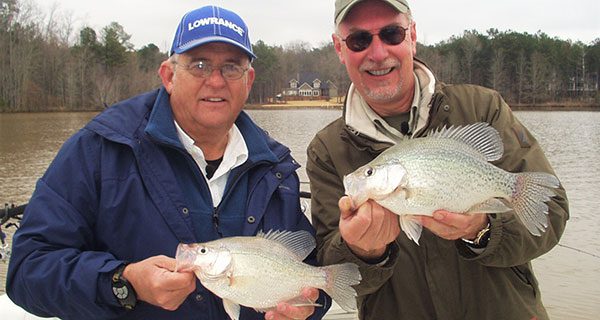
As our area lakes begin to warm up into the upper 50’s and lower 60’s, the spring crappie bite should fire up, and they will be going shallow to start spawning. Knowing the exact dates for the spawn is somewhat of a mystery, but water temperature is a very good indicator. It pays to spend a little time on the water doing some scouting for likely areas and continuing to check the temps.
Pre-Spawn: The week or so before the actual spawn can sometimes be more productive than the spawning time itself, as both the males and females will be putting on their feedbags. Pre-spawn starts around 55 degrees or so. In this case, fish a little deeper water than you might during the spawn. Depending on the specific lake and the available structure, pre-spawn depths could be 8 to 20 feet. DownScan on your Simrad or Lowrance units will be super-valuable, because you’ll be able to actually see the crappie schools around structure. Once you locate the school, drop a marker on the spot and either anchor up, or set your trolling motor on anchor about 20 to 30 feet off the mark, and then make a few casts.
Spawn: A good indication the spawn is about to happen is when you start catching mostly males, which are considerably smaller than the females. The males show up first to ‘build’ the nests, and then wait for an interested female to stop by and set up house. When you’re catching the big slab females in shallow water and on structure, it’s a good bet the spawn is in full swing. On the back side of the spawn, the males will hang around to guard the nest until the eggs hatch, so you have a pretty good window of opportunity for doing some catching. The pre-spawn, spawn and post-spawn period could be a few days or a few weeks. Not all the females will be ready to mate at the same time, so you could have some really fishy days for a week or two.
Tactics: Light tackle is the key with super light line in 2 to 4-pound test and super light jigs in 1/16 and 1/32 ounce. You’ve got a plethora of trailer colors to choose from too. I go with the old adage of clear water means light colored plastics, and dingy water equals darker or more vivid colored tails. If there’s a couple of you fishing from the boat, I’d suggest everyone start with different colors and let the fish tell you what they like that day. Since you’re casting super light jigs, be sure to give the lures time to sink. If you’re fishing vertical structure, cast just beyond it, so as the jig sinks and the line comes tight, your jig is still on the mark. Live minnows under a cork work really well too, especially when you’re fishing around docks and brush piles near the bank. You can adjust the depth of the minnow with the float in an attempt to keep it from getting tangled often. Use very light wire hooks, so if you do get hung up, you can pull the line and the hook will bend to get it free.
It’s hard to beat a bucket of crappie to make a great fish fry. Even though crappie are prolific in some of our lakes, it’s a good idea to consider responsible resource management. Catch and keep enough for dinner, and leave the rest for another day or another angler. So get out there and have a great crappie day!